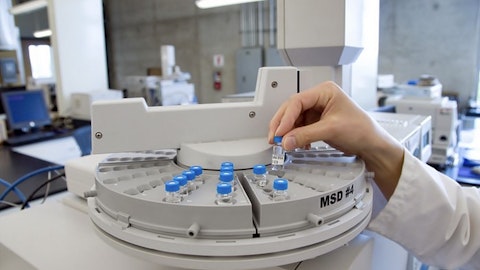Given that billionaire Cliff Asness was a research assistant to the founder of the Efficient Market Theory, it might seem logical that he wouldn’t particularly care to know the fundamentals of a stock, since most Efficient Market Theory proponents believe price reflects all relevant fundamentals of a security at any given time. But as it turns out, Asness isn’t an Efficient Market Theory supporter, and his hedge fund’s solid performance over the years has shown that the market can be beaten by those resourceful enough to figure it out. Seeing as Asness’ $50 billion+ fund AQR Capital Management recently filed its 13F, let’s take a closer look at Asness’ top stock picks, which include Apple Inc. (NASDAQ:AAPL), Microsoft Corporation (NASDAQ:MSFT), Pfizer Inc. (NYSE:PFE), UnitedHealth Group Inc (NYSE:UNH), and Gilead Sciences, Inc. (NASDAQ:GILD).
But why do we track hedge fund activity? From one point of view we can argue that hedge funds are consistently underperforming when it comes to net returns over the last three years, when compared to the S&P 500. But that doesn’t mean that we should completely neglect their activity. There are various reasons behind the low hedge fund returns. Our research indicated that hedge funds’ long positions actually beat the market. In our back-tests covering the 1999-2012 period hedge funds’ top small-cap stocks edged the S&P 500 index by double digits annually. The 15 most popular small-cap stock picks among hedge funds also bested passive index funds by around 53 percentage points over the 36 month period beginning from September 2012 (see the details here).
#5 Gilead Sciences, Inc. (NASDAQ:GILD)
Shares held (as of September 30): 4.77 million
Total Value (as of September 30): $468.22 million
Percent of Portfolio (as of September 30): 0.94%
Given that Gilead Sciences, Inc. (NASDAQ:GILD)’s Sovaldi and Harvoni have done very well this year, with Harvoni bringing in third quarter sales of $3.3 billion and Sovaldi reporting revenue of $1.46 billion, analysts are bullish on the company. One analyst has a ‘Strong Buy’ rating, 17 have a ‘Buy’ rating, and six have a ‘Hold’ rating. The lone analyst with an ‘Underperform’ rating has a price target of $107 per share, or 2% higher than Gilead’s current price. The funds we track are also bullish. A total of 90 funds that we track were long GILD in the third quarter, up from 84 in the second quarter. If Gilead Sciences’ Hep C drugs maintain their sales in the face of increasing competition, look for GILD’s forward P/E of 8.7 to rise substantially.
#4 UnitedHealth Group Inc (NYSE:UNH)
Shares held (as of September 30): 4.58 million
Total Value (as of September 30): $531.22 million
Percent of Portfolio (as of September 30): 1.06%
UnitedHealth Group Inc (NYSE:UNH) reported solid earnings for its third quarter, with EPS of $1.65 and revenue of $41.5 billion, exceeding analyst expectations on both the top and bottom lines. Revenue rose by 26.7% year-over-year, while premium increased by 9.8% year-over-year, well over the rate of inflation. Cash flow from operations was $2.8 billion. Hedge funds were a little less optimistic about the company as a whole, however, as 51 out of the around 730 elite funds we track were long the stock at the end of September versus 61 funds that owned the stock at the end of June. UNH shareholders aren’t complaining, however, as the value of their shares are up 18.3% year-to-date.
Follow Gilead Sciences Inc. (NASDAQ:GILD)
Follow Gilead Sciences Inc. (NASDAQ:GILD)
Receive real-time insider trading and news alerts
Follow Unitedhealth Group Inc (NYSE:UNH)
Follow Unitedhealth Group Inc (NYSE:UNH)
Receive real-time insider trading and news alerts
#3 Pfizer Inc. (NYSE:PFE)
Shares held (as of September 30): 16.92 million
Total Value (as of September 30): $531.35 million
Percent of Portfolio (as of September 30): 1.06%
Pfizer Inc. (NYSE:PFE) is one of the largest healthcare companies in the world. The company manufactures and markets numerous blockbuster drugs, including Lyrica, Celebrex, Zyvox, and Norvasc and has a pipeline of promising drug candidates, such as Palbociclib, PF-06290510, and PF-06425090, all of which have billion-dollar-a-year potential. Because the government grants exclusivity to patented drugs and many people can’t go with them, Pfizer has substantial pricing power and steady cash flows. Although some of Pfizer’s drug patents will expire in the coming years, management is addressing the issue with M&A. Pfizer recently announced that it is merging with Irish drug maker Allergan, the maker of Botox, various biosimilars, and more than 1,000 generics and branded OTC products, in a $160 billion deal. If antitrust agencies agree to the deal, Pfizer will lower its taxes substantially and increase its earnings per share growth rate.
Follow Pfizer Inc (NYSE:PFE)
Follow Pfizer Inc (NYSE:PFE)
Receive real-time insider trading and news alerts
#2 Microsoft Corporation (NASDAQ:MSFT)
Shares held (as of September 30): 12.4 million
Total Value (as of September 30): $548.92 million
Percent of Portfolio (as of September 30): 1.10%
Although it’s now a multi-platform world, with Android and iOS vying for consumer and developer attention in addition to Windows, Microsoft Corporation (NASDAQ:MSFT) is rapidly diversifying itself. The company launched Skype translator this year and should release a consumer version of HoloLens in the coming years. If HoloLens is anything like the media previews, Microsoft could have a must-have consumer product on its hands. Meanwhile, Microsoft Surface continues to make inroads with consumers, as Microsoft’s online tablet sales have eclipsed Apple’s online iPad sales. Shares of Microsoft are up 23.64% year-to-date.
Follow Microsoft Corp (NASDAQ:MSFT)
Follow Microsoft Corp (NASDAQ:MSFT)
Receive real-time insider trading and news alerts
#1 Apple Inc. (NASDAQ:AAPL)
Shares held (as of September 30): 7.58 million
Total Value (as of September 30): $835.67 million
Percent of Portfolio (as of September 30): 1.67%
Seeing as it’s the largest company by market capitalization, it’s not surprising that Apple Inc. (NASDAQ:AAPL) would also be AQR’s largest holding, which amasses 1.67% of the fund’s portfolio. Apple recently added to its $200 billion cash pile when Samsung paid the company $548 million on December 14 for infringing on some of Apple’s patents. Although $548 million is pocket change for Apple, Samsung’s payment is significant in that it means ultra-low cost producer Xiaomi will likely have to pay Apple and other smartphone patent owners expensive royalties if it were to come to the United States or Europe. It’s not that Apple can’t handle the competition from Xiaomi, however. Apple’s sales have almost doubled year-over-year in China despite Xiaomi’s strong presence in the country.
Disclosure:None




